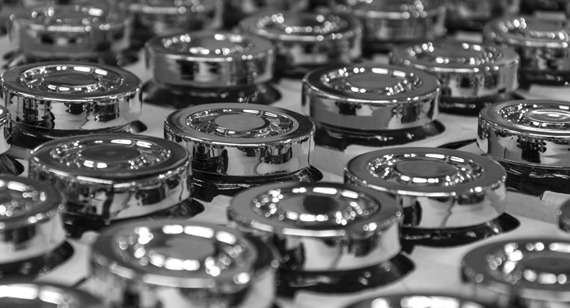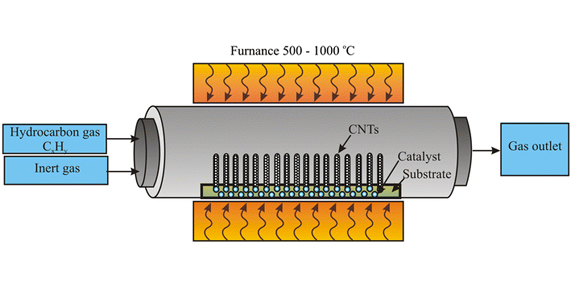15 years one-stop China custom CNC machining parts factory
 273 |
Published by VMT at Sep 10 2024
273 |
Published by VMT at Sep 10 2024
Vacuum coating is a vital surface treatment technology used in various industries to enhance the properties of parts and components. It involves the deposition of thin films of material onto a substrate in a vacuum environment, enabling high-performance coatings with enhanced durability, reflectivity, corrosion resistance, and insulation properties. This process is essential for a wide range of applications, from precision CNC machining parts to optical and electronic components. In this comprehensive guide, we will explore the vacuum coating process, the metals used, the benefits, and its applications.
The vacuum coating process involves applying a thin layer of metal or other material to a substrate in a controlled vacuum environment. By eliminating air and contaminants during the coating process, vacuum coating achieves a high-quality, uniform layer of material that can significantly enhance the physical, chemical, and aesthetic properties of the part. This process is often used to protect CNC machining parts from wear, corrosion, and oxidation, while also adding functional properties such as electrical conductivity or insulation.

Several metals can be effectively vacuum coated depending on the intended application and required material properties. Below are some of the most commonly used metals for vacuum coating:
Aluminum: Aluminum is one of the most popular metals for vacuum coating due to its excellent reflectivity, lightweight properties, and ability to form a protective oxide layer. Aluminum coatings are widely used for optical components, automotive parts, and reflective surfaces in lighting applications.
Copper: Copper is used for vacuum coatings where electrical conductivity is required, such as in electrical and electronic applications. Its excellent thermal conductivity also makes it ideal for coating parts in heat management applications, such as heat sinks and conductive surfaces.
Titanium: Titanium is known for its high strength, lightweight, and corrosion resistance, making it suitable for vacuum coating applications in aerospace, medical devices, and decorative finishes. Titanium nitride (TiN) coatings are often applied to cutting tools and wear-resistant parts for their hardness and durability.
Vacuum coating encompasses several deposition techniques that allow for the precise application of thin films on various substrates. The most common methods of vacuum coating are:
Metallization Methods
1. Physical Vapor Deposition (Thermal Evaporation)
Physical Vapor Deposition (PVD) is a process where the metal is vaporized in a vacuum chamber by applying heat or an electron beam. The vaporized metal atoms then travel through the vacuum and condense on the substrate surface, forming a thin coating. This method is widely used for decorative coatings, functional coatings on cutting tools, and wear-resistant surfaces.

2. Chemical Vapor Deposition (Sputtering)
In chemical vapor deposition (CVD) or sputtering, a gas containing the desired coating material is introduced into the vacuum chamber. An electric field bombards the gas molecules, causing them to disintegrate and deposit a thin film of the material onto the substrate. Sputtering is commonly used for optical coatings, semiconductor components, and protective layers in electronic devices.

Vacuum Coating Process Flow
The vacuum coating process involves several stages, from part preparation to final inspection. Here’s a step-by-step breakdown of the typical vacuum coating process:
Step 1 – Custom Fixtures and Part Clamping
Before the process begins, custom fixtures and clamps are designed and prepared to hold the CNC machining parts in place securely. Proper clamping ensures that the parts receive even and consistent coating during the deposition process.
Step 2 – Loading
The parts are then loaded into the vacuum chamber, ensuring that they are positioned correctly to receive optimal coating. Proper alignment and placement are essential for achieving uniform thickness and avoiding defects.
Step 3 – Apply Primer
In some applications, a primer layer is applied to the substrate to enhance the adhesion of the vacuum coating. This primer improves the bond between the part and the coating, ensuring long-lasting performance.
Step 4 – Vacuum Coating
Once the parts are secured and the chamber is sealed, a vacuum is created to remove all air and contaminants. The coating material (metal or compound) is then vaporized, and the coating is deposited on the surface of the parts through PVD or sputtering. This stage is crucial for achieving the desired coating properties, such as thickness, uniformity, and reflectivity.
Step 5 – Apply Topcoat
For some applications, a topcoat is applied to protect the vacuum coating from environmental damage, abrasion, or oxidation. This topcoat can also enhance the part's aesthetic appeal, adding color or gloss.
Step 6 – Quality Inspection
After the coating is applied, each part undergoes a thorough quality inspection to ensure the coating meets the required standards. Visual inspections, thickness measurements, and adhesion tests are performed to verify the integrity and consistency of the coating.

Standards:
To maintain high-quality production, vacuum coating processes must comply with international quality standards, such as:
Vacuum coating offers numerous benefits that make it an attractive option for a wide range of applications:
Low Cost: Despite being a high-precision process, vacuum coating is cost-effective, especially when applied to large batches of parts. The controlled environment and high deposition rates reduce waste and increase efficiency.
Adds Reflective Properties to Parts: Vacuum-coated parts often have enhanced reflectivity, making them suitable for optical applications, such as mirrors, lenses, and reflective surfaces for lighting fixtures.
Protects from Oxygen and Moisture: Vacuum coatings provide a barrier that protects parts from oxidation, corrosion, and moisture, extending the service life of the components.
Creates or Limits Electrical Conductivity: Depending on the coating material used, vacuum coating can either enhance or limit the electrical conductivity of parts, making it versatile for electronic and electrical applications.
Safer than Other Processes, Such as Chrome Plating: Vacuum coating is generally safer for the environment and workers compared to traditional processes like chrome plating, which involves toxic chemicals.
Functional and Decorative Coating Requirements: Vacuum coatings can serve both functional purposes (such as corrosion resistance, electrical insulation) and decorative purposes (such as enhancing appearance and adding colors).
While both vacuum coating and electroplating are used to apply thin layers of metal onto substrates, they differ significantly in their processes and outcomes.
1. Metal Coating Material
Vacuum coating allows for the deposition of a wide range of metals, including aluminum, titanium, and gold. Electroplating is more commonly used with metals like nickel, copper, and chromium.
2. Electroplating Environment
Electroplating involves immersing the part in a solution with metal ions and using an electric current to coat the part. In contrast, vacuum coating occurs in a vacuum chamber, which ensures a clean, controlled environment and prevents contamination.
3. Color and Durability
Vacuum coatings often produce a more uniform and durable finish, with the ability to add various colors, whereas electroplating can have limitations in achieving certain colors or uniformity. Electroplated coatings, however, may be thicker and more suited for heavy-duty applications.
4. Environmental Friendliness
Vacuum coating is more environmentally friendly compared to electroplating, which involves toxic chemicals and can produce hazardous waste. Vacuum coating does not require the use of harmful chemicals, reducing its environmental impact.
Vacuum coating is used in a wide range of industries, offering both functional and decorative benefits:
1. Vacuum Coating Decoration
Vacuum coating is often used to enhance the appearance of consumer goods, automotive trim, and jewelry. It allows manufacturers to add metallic finishes and colors to plastic, glass, or metal components, creating a high-quality appearance.
2. Vacuum Metallization for Insulation Applications
In electronic and electrical applications, vacuum metallization is used to create thin, insulating layers that protect components from electrical interference or heat. It’s commonly used in capacitors, printed circuit boards, and semiconductor devices.
3. Vacuum Coating Can Improve Barrier Properties
In packaging and food preservation, vacuum coatings are used to create barriers that prevent moisture, oxygen, and other contaminants from damaging the product inside. This improves the shelf life of food and pharmaceutical products.
4. Vacuum Coating for Reflectivity of Optical Parts
Optical components, such as mirrors, lenses, and reflectors, benefit from vacuum coatings that enhance reflectivity. These coatings are crucial in applications like telescopes, cameras, and lighting systems, where precise light reflection is required.
Vacuum coating is a versatile and essential process in modern manufacturing, providing functional and aesthetic enhancements to CNC machining parts, electronics, optical components, and more. By offering superior corrosion resistance, electrical insulation, and decorative finishes, vacuum coating meets the needs of industries ranging from automotive to aerospace. Its environmentally friendly nature and cost-effectiveness make it a popular choice for precision CNC machining factories and custom CNC machining services.

Is Vacuum Metallization Better Than Chrome Plating?
Vacuum metallization is often considered a safer and more environmentally friendly alternative to chrome plating. It provides excellent decorative finishes and corrosion protection without the hazardous chemicals associated with chrome plating.
Is Vacuum Coating Expensive?
Vacuum coating is generally cost-effective, especially for high-volume production. The cost can vary depending on the complexity of the parts and the type of coating required.
What is the Thickness of Vacuum Coating?
Vacuum coatings are typically very thin, ranging from a few nanometers to a few microns, depending on the application. This thin layer provides significant benefits without adding bulk or weight to the part.
Which Metal is Suitable for Metallization?
Common metals used in vacuum metallization include aluminum, copper, titanium, gold, and silver, depending on the application’s requirements for reflectivity, conductivity, or corrosion resistance.
Why is Aluminum Preferred for Metallization?
Aluminum is preferred for metallization due to its excellent reflectivity, lightweight properties, and affordability. It forms a protective oxide layer that enhances the durability of the coating.
What is Better Than Chrome Plating?
Depending on the application, vacuum coating or PVD may be a better alternative to chrome plating. These methods provide a more environmentally friendly process, better control over coating thickness, and a wider range of material options.
What is the Impact of Vacuum Coating on the Environment?
Vacuum coating is considered environmentally friendly compared to processes like electroplating and chrome plating, as it does not use hazardous chemicals and produces less waste. Additionally, the controlled vacuum environment ensures minimal material waste during the coating process.
This comprehensive guide on vacuum coating highlights its importance in enhancing the properties of CNC machining parts and its wide-ranging applications across industries. Whether for custom CNC machining projects or large-scale production in CNC machining factories, vacuum coating offers reliable, cost-effective solutions for both functional and decorative needs.
